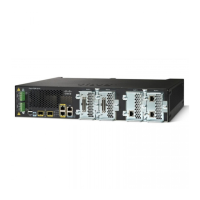16-2
Catalyst 3550 Multilayer Switch Software Configuration Guide
78-11194-09
Chapter 16 Configuring STP
Understanding Spanning-Tree Features
• Spanning-Tree Interoperability and Backward Compatibility, page 16-10
• STP and IEEE 802.1Q Trunks, page 16-10
• VLAN-Bridge Spanning Tree, page 16-10
For configuration information, see the “Configuring Spanning-Tree Features” section on page 16-11.
For information about optional spanning-tree features, see Chapter 18, “Configuring Optional
Spanning-Tree Features.”
STP Overview
STP is a Layer 2 link management protocol that provides path redundancy while preventing loops in the
network. For a Layer 2 Ethernet network to function properly, only one active path can exist between
any two stations. Multiple active paths among end stations cause loops in the network. If a loop exists
in the network, end stations might receive duplicate messages. Switches might also learn end-station
MAC addresses on multiple Layer 2 interfaces. These conditions result in an unstable network.
Spanning-tree operation is transparent to end stations, which cannot detect whether they are connected
to a single LAN segment or a switched LAN of multiple segments.
The STP uses a spanning-tree algorithm to select one switch of a redundantly connected network as the
root of the spanning tree. The algorithm calculates the best loop-free path through a switched Layer 2
network by assigning a role to each port based on the role of the port in the active topology:
• Root—A forwarding port elected for the spanning-tree topology
• Designated—A forwarding port elected for every switched LAN segment
• Alternate—A blocked port providing an alternate path to the root port in the spanning tree
• Backup—A blocked port in a loopback configuration
Switches that have ports with these assigned roles are called root or designated switches.
Spanning tree forces redundant data paths into a standby (blocked) state. If a network segment in the
spanning tree fails and a redundant path exists, the spanning-tree algorithm recalculates the
spanning-tree topology and activates the standby path. Switches send and receive spanning-tree frames,
called bridge protocol data units (BPDUs), at regular intervals. The switches do not forward these frames
but use them to construct a loop-free path. BPDUs contain information about the sending switch and its
ports, including switch and MAC addresses, switch priority, port priority, and path cost. Spanning tree
uses this information to elect the root switch and root port for the switched network and the root port and
designated port for each switched segment.
When two interfaces on a switch are part of a loop, the spanning-tree port priority and path cost settings
determine which interface is put in the forwarding state and which is put in the blocking state. The
spanning-tree port priority value represents the location of an interface in the network topology and how
well it is located to pass traffic. The path cost value represents the media speed.
Spanning-Tree Topology and BPDUs
The stable, active spanning-tree topology of a switched network is determined by these elements:
• The unique bridge ID (switch priority and MAC address) associated with each VLAN on each switch
• The spanning-tree path cost to the root switch
• The port identifier (port priority and MAC address) associated with each Layer 2 interface

